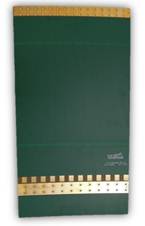Boulder Wind Power (BWP) has announced that the latest test results of its patented printed circuit board (PCB) stator prove a clear advantage in insulation strength and durability as compared with the insulation in traditional wind power generators. In addition to better performance, the reduced weight and modular design of a PCB stator significantly lowers the expected operations and maintenance costs for a BWP generator while driving increased energy production.
Printed circuit boards as generator stators have been used extensively in a variety of applications by CORE Innovation (CORE), the developer of the printed circuit board stator technology. CORE originally developed PCBs for generator stators in the early 2000s for use in motors of variable speed, outdoor lawn-equipment products, but since, has steadily increased the size and scope of these applications. “CORE Outdoor Power Equipment, a sister company to CORE Innovation and Boulder Wind Power, ships 50,000 to 100,000 units of a range of gasoline-less professional products including grass trimmers, leaf blowers, lawn edgers, and lawn mowers annually.” Says CORE OPE’s President Lincoln Jore. “Given the PCB technology’s reliability and the broad application to variable-speed motors and generators, units in size up to 750 kW have been developed with more products in the pipeline.”
Since its founding in 2009, Boulder Wind Power has made significant improvements to advance PCB technology for use in demanding wind power applications. Leveraging new techniques in the manufacturing process has resulted in increased copper coil density in the PCB and increased system performance. In addition, BWP has invested over $1 million to bring state-of-the art testing capabilities to its Louisville, Colo. headquarters where engineers are testing the PCB stators to measure performance under extreme electrical and mechanical loads – all with the goal of ensuring a 25-year lifetime for the PCB stators in the harshest operating conditions.
“Our patented PCB technology uses proven industry-standard processes that result in unparalleled conductor and insulation system uniformity, while avoiding the traditional vulnerable and labor-intensive manufacturing processes for generator windings,” says BWP’s VP of Engineering, Paulo Guedes-Pinto, “The modular design means up-tower ‘plug and play’ replacement without a crane, significantly reducing downtime and O&M costs.”
BWP recently completed voltage endurance tests on its PCB stators, comparing PCB stator insulation with traditional mica tape insulation systems on form wound coils. Results indicate that the insulation in a PCB stator lasts 80-100 times longer than mica tape insulation under the same dielectric stress conditions. BWP gives the following advantages of the PCB stator as reasons for its exceptional reliability:
Contrary to conventional winding manufacturing, the PCB manufacturing is automated and almost independent of operator’s skill and experience. The PCB winding end turns are completely supported by the PCB insulation with no discontinuity between the coil straight section and its end turns. This eliminates stress risers typically found in conventional windings, notably in the section where coils emerge out of the iron core.
- The electromagnetic forces acting on the coil conductors are better supported and transmitted through the PCB structure. The insulation system is nearly homogeneous, employing FR4 epoxy laminate completely encapsulating the entire winding, including end turns.
- The insulation materials have similar coefficients of thermal expansion greatly reducing thermal stresses on the conductors and PCB in general.
- There is a minimal temperature gradient between the copper windings and the cooling medium in contrast to conventional generators where the temperature in the copper coils is much higher than the surrounding iron core and cooling medium.
BWP Chief Executive Officer Andy Cukurs added, “Printed circuit boards have been used in critical applications such as medical electronics and aerospace since they were developed in the 1940’s. We’ve taken the lessons learned in these demanding applications, applied and built upon on those established processes as CORE Innovation has successfully done, and continued to improve the technology for use in the wind industry allows BWP to introduce valuable technology that significantly improves generator performance and reliability.”
“Improving generator reliability and output is important for the wind industry as it competes with traditional energy sources,” says Cukurs. “Making proven technological advancements to the generator mechanics is an important piece to improving the reliability and profitability of wind energy – especially for countries with rigorous renewable energy requirements as well as those that seek cleaner sources of generation.”
Boulder Wind Power
www.boulderwindpower.com
Filed Under: Generators, News, Turbines





